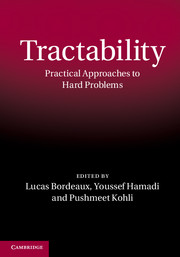Book contents
- Frontmatter
- Contents
- Contributors
- Introduction
- Part 1 Graphical Structure
- Part 2 Language Restrictions
- Part 3 Algorithms and their Analysis
- Part 4 Tractability in Some Specific Areas
- 10 Efficient Submodular Function Minimization for Computer Vision
- 11 Towards Practical Graph-Based, Iteratively Decoded Channel Codes: Insights through Absorbing Sets
- Part 5 Heuristics
10 - Efficient Submodular Function Minimization for Computer Vision
from Part 4 - Tractability in Some Specific Areas
Published online by Cambridge University Press: 05 February 2014
- Frontmatter
- Contents
- Contributors
- Introduction
- Part 1 Graphical Structure
- Part 2 Language Restrictions
- Part 3 Algorithms and their Analysis
- Part 4 Tractability in Some Specific Areas
- 10 Efficient Submodular Function Minimization for Computer Vision
- 11 Towards Practical Graph-Based, Iteratively Decoded Channel Codes: Insights through Absorbing Sets
- Part 5 Heuristics
Summary
Markov Random Fields have been successfully applied to many computer vision problems such as image segmentation, 3D reconstruction, and stereo. The problem of estimating the Maximum a Posteriori (MAP) solution of models such as Markov Random Fields (MRF) can be formulated as a function minimization problem. This has made function minimization an indispensable tool in computer vision. The problem of minimizing a function of discrete variables is, in general, NP-hard. However, functions belonging to certain classes of functions, such as submodular functions, can be minimized in polynomial time. In this chapter, we discuss examples of popular models used in computer vision for which the MAP inference problem results in a tractable function minimization problem. We also discuss how algorithms used in computer vision overcome challenges introduced by the scale and form of function minimization problems encountered in computer vision.
Labeling Problems in Computer Vision
Many problems in computer vision and scene understanding can be formulated in terms of finding the most probable values of certain hidden or unobserved variables. These variables encode some property of the scene and can be continuous or discrete. These problems are commonly referred to as labelling problems as they involve assigning a label to the hidden variables. Labelling problems occur in many forms, from lattice based problems of dense stereo and image segmentation discussed in [6, 40] to the use of pictorial structures for object recognition as done by [10]. Some examples of problems which can be formulated in this manner are shown in Figure 10.1.
Information
- Type
- Chapter
- Information
- TractabilityPractical Approaches to Hard Problems, pp. 285 - 303Publisher: Cambridge University PressPrint publication year: 2014
